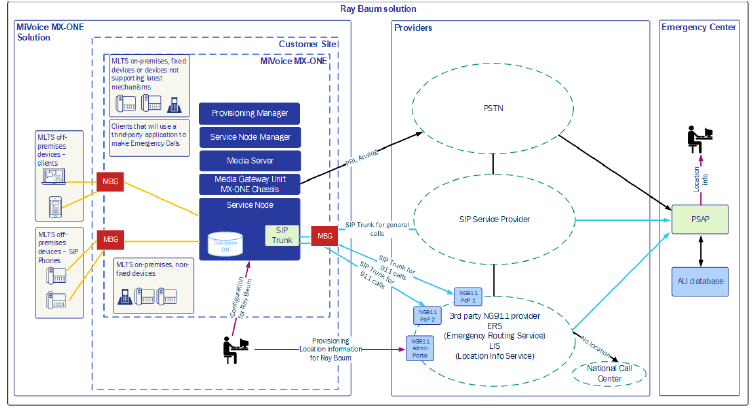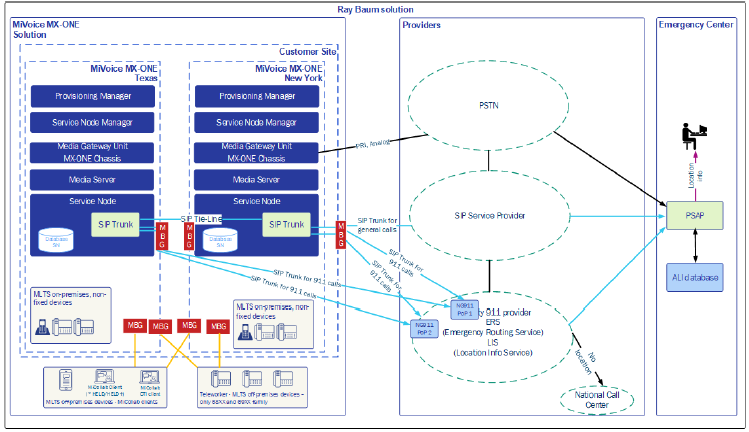MX-ONE RAY BAUM – High-level Architecture
The MX-ONE implements RAY BAUM in conjunction with NG911 providers as the MX-ONE 911 solution alone does not meet the legislated requirements for RAY BAUM for all non-fixed devices.
For Kari’s Law requirements, the MX-ONE can be preconfigured for the direct dialing of 911 (emergency calls), without having to dial any prefix or access code. The 911 calls are sent via SIP trunk to the NG911 provider, and the NG911 provider will redirect to the appropriate Public Safety Answering Points (PSAPs) based on the Civic Address of the location as identified by the NG911 provider.
The MX-ONE solution primarily sends Location identifiers to the NG911 provider during emergency calls. The NG911 provider will look up these Location identifiers to determine the Civic Address which they use in the signaling to the PSAP. The NG911 provider validates the Civic Address when the location is created in their database.
With the RAY BAUM’S Act solution, the Mitel MiVoice Border Gateway (MBG) is used as SBC (Session Border Controller) between the MX-ONE and the third-party NG911 provider in the solution. If a customer has an existing MBG used by SIP trunks, this can be upgraded to release 11.3 or later and used for the connection to the NG911 Emergency Routing Service (ERS). Additionally, the MBG can be used for MiCollab Remote User (Teleworkers). Standard engineering guidelines apply.
Mitel is only validating the solution with the MBG, customers utilizing other vendors Session Border Controllers (SBC) will need to work their SBC vendor for verification with NG911 ERS services.
The integration described in this guide requires that the customer has a valid service agreement with an NG911 provider.
Mitel does not provide this service agreement directly. To support Kari’s law compliant local notifications, the solution will use the NG911 provider’s notification application.
The MX-ONE notifications (including Mitel Revolution) provide supplementary information and are not sufficient to meet Kari’s law on their own when the MX-ONE is used in conjunction with an ERS.
Emergency Callback behavior is dependent on the NG911 provider selected. Some NG911 providers provide a DID service where they use their own DIDs when contacting the PSAP and will route callbacks back to the MX-ONE over the SIP trunk. Other NG911 providers will pass on the callback information from the call-server (or if none is provided, use a fixed callback field in their Location database), which will enable the PSTN to route the call back from the PSAP over the public PSTN to the specified callback number. In this case, the MX-ONE will need to use the existing DID features to route the incoming emergency callback from the public PSTN.

The following figure shows a high-level view of the MX-ONE RAY BAUM architecture for a networked MX-ONE system that uses SIP tie-line.
In this use case, both MX-ONE systems have connections with the NG911 provider to avoid single point of failure. MX-ONE systems can be optionally configured to provide the emergency information (A number (calling party) or Location Identifier (ID)) via tie-line which provides another layer of redundancy for the solution.
